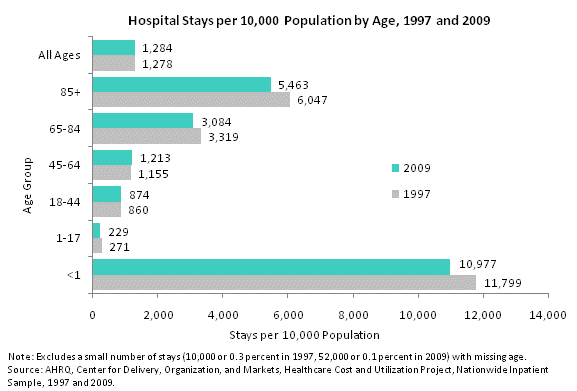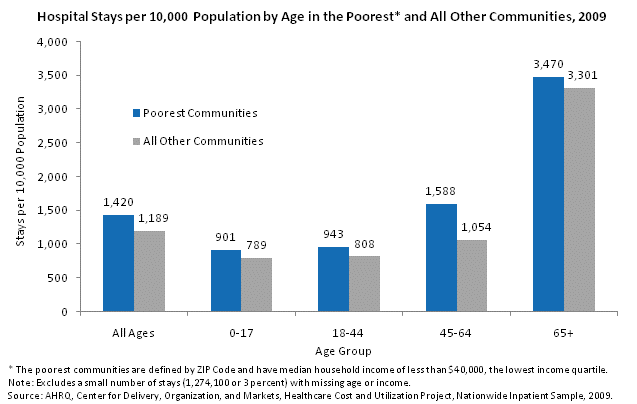|
TABLE OF CONTENTS HIGHLIGHTS INTRODUCTION HCUP PARTNERS 1. OVERVIEW 2. DIAGNOSES 3. PROCEDURES 4. COSTS 5. WOMEN'S HEALTH SOURCES/METHODS DEFINITIONS FOR MORE INFO ACKNOWLEDGMENTS CITATION FACTS & FIGURES 2009 PDF |
EXHIBIT 1.5 Patient Age (PDF) 1.5a

Hospital stays per 10,000 population by age, 1997 and 2009. Bar chart. Stays per 10,000 population. 1997. Less than 1: 11,799; 1 to 17: 271; 18 to 44: 860; 45 to 64: 1,155; 65 to 84: 3,319; 85 and over: 6,047; all ages: 1,278. 2009. Less than 1: 10,977; 1 to 17: 229; 18 to 44: 874; 45 to 64: 1,213; 65 to 84: 3,084; 85 and over: 5,463; all ages: 1,284. Note: Excludes a small number of stays (10,000 or 0.3% in 1997, 52,000 or 0.1% in 2009) with missing age. Source: AHRQ, Center for Delivery, Organization, and Markets, Healthcare Cost and Utilization Project, Nationwide Inpatient Sample, 1997 and 2009.
Across all age groups, there were 1,284 hospital stays for every 10,000 persons in the United States in 2009, essentially the same as the rate of 1,278 stays in 1997.
1.5b

Hospital stays per 10,000 population by age in the poorest and all other communities, 2009. Column chart. Stays per 10,000 population. Poorest communities. All ages: 1,420; 0 to 17: 901; 18 to 44: 943; 45 to 64: 1,588; 65 and over: 3,470. All other communities. All ages: 1,189; 0 to 17: 789; 18 to 44: 808; 45 to 64: 1,054; 65 and over: 3,301. Note: The poorest communities are defined by ZIP Code and have median household income of less than $40,000, the lowest income quartile. Note: Excludes a small number of stays (1,274,100 or 3%) with missing age or income. Source: AHRQ, Center for Delivery, Organization, and Markets, Healthcare Cost and Utilization Project, Nationwide Inpatient Sample, 2009.
|
| Internet Citation: Facts and Figures 2009. Healthcare Cost and Utilization Project (HCUP). November 2011. Agency for Healthcare Research and Quality, Rockville, MD. hcup-us.ahrq.gov/reports/factsandfigures/2009/exhibit1_5.jsp. |
| Are you having problems viewing or printing pages on this website? |
| If you have comments, suggestions, and/or questions, please contact hcup@ahrq.gov. |
| If you are experiencing issues related to Section 508 accessibility of information on this website, please contact hcup@ahrq.gov. |
| Privacy Notice, Viewers & Players |
| Last modified 11/9/11 |